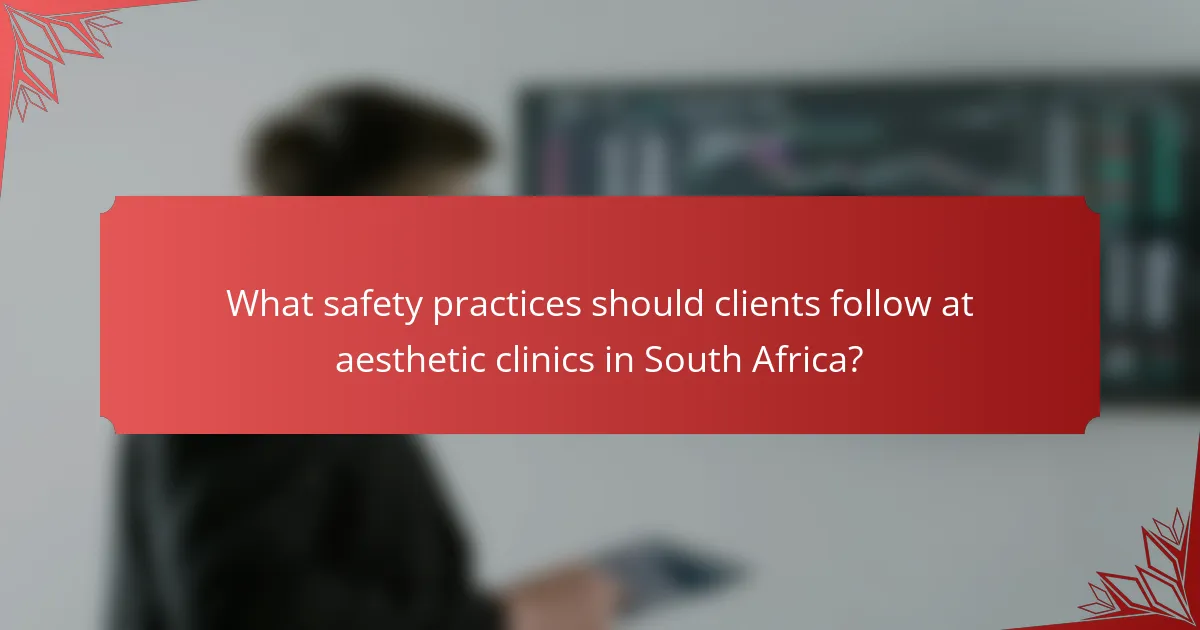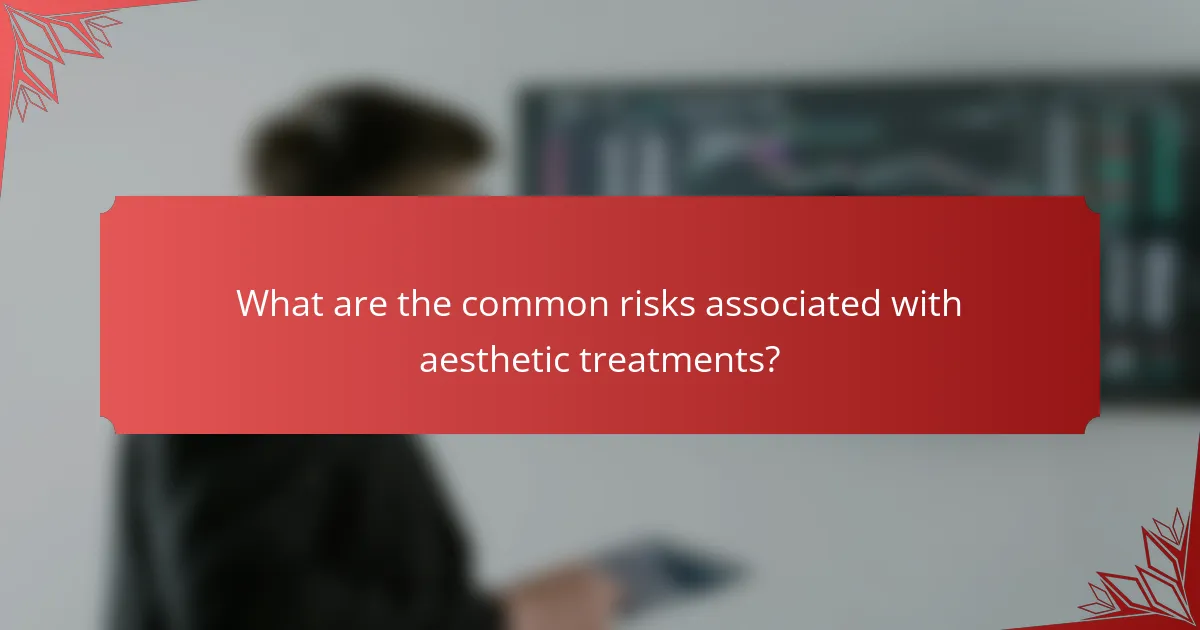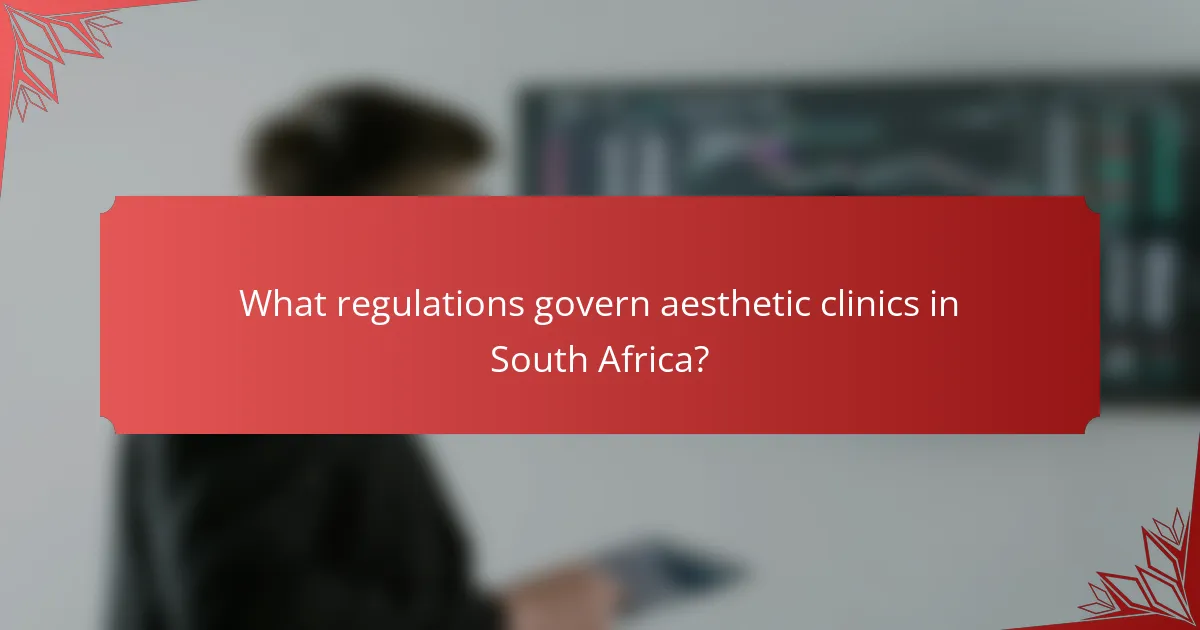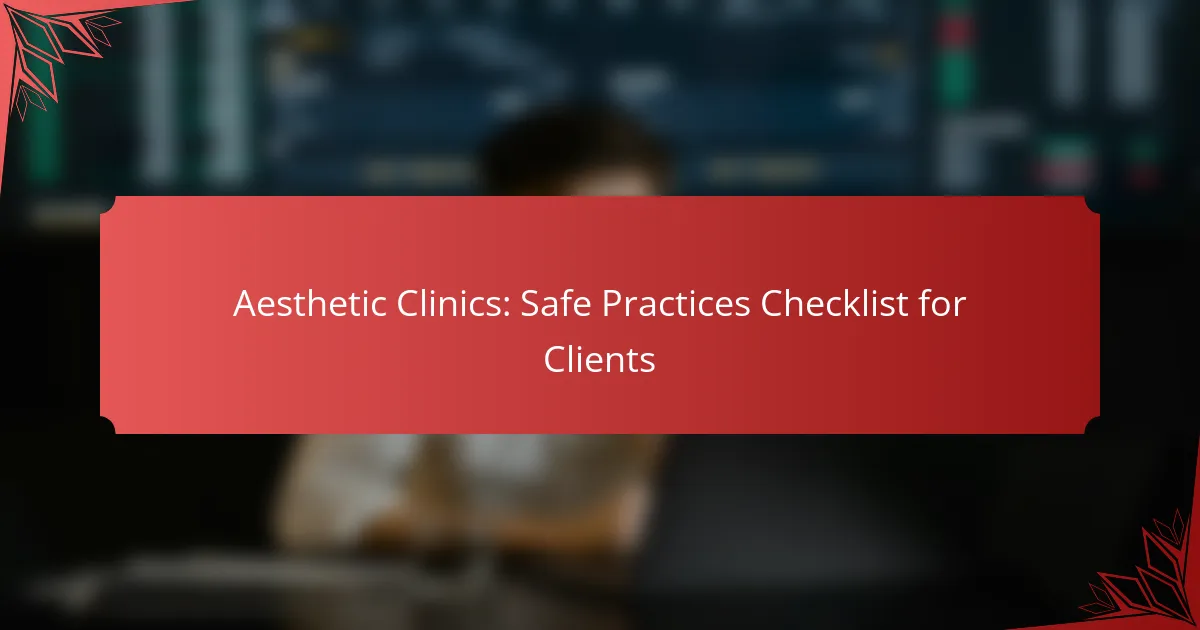When considering aesthetic treatments, clients in South Africa must prioritize safety by verifying clinic credentials and practitioner qualifications. By conducting thorough research and ensuring high hygiene standards, individuals can mitigate potential risks associated with these procedures. Understanding the inherent risks, such as allergic reactions and infections, is crucial for making informed decisions and ensuring a safe experience.

What safety practices should clients follow at aesthetic clinics in South Africa?
Clients in South Africa should prioritize safety by verifying clinic credentials, checking practitioner qualifications, and ensuring high hygiene standards. Following these practices can help mitigate risks associated with aesthetic procedures.
Verify clinic accreditation
Before undergoing any treatment, confirm that the aesthetic clinic is accredited by relevant South African health authorities. Accreditation ensures that the clinic meets established safety and quality standards.
Look for certifications from organizations such as the Health Professions Council of South Africa (HPCSA) or the South African Society of Aesthetic Medicine (SASAM). This can provide peace of mind regarding the clinic’s legitimacy.
Check practitioner qualifications
Ensure that the practitioner performing the procedure is qualified and registered with the HPCSA. This includes checking their educational background and any specialized training in aesthetic treatments.
Ask for proof of qualifications and experience, particularly in the specific procedure you are considering. Practitioners should have a solid track record and be able to provide examples of their work.
Review client testimonials
Reading client testimonials can provide insights into the experiences of others who have undergone treatments at the clinic. Look for reviews on independent platforms to get an unbiased perspective.
Pay attention to both positive and negative feedback, as this can help you gauge the clinic’s overall reputation and the satisfaction level of previous clients.
Inspect hygiene standards
Hygiene is crucial in aesthetic clinics to prevent infections and complications. Observe the clinic’s cleanliness upon arrival and inquire about their sterilization protocols for instruments and equipment.
Ensure that the clinic follows strict hygiene practices, such as using disposable materials where necessary and maintaining a clean environment. This can significantly reduce the risk of adverse outcomes.
Confirm product authenticity
Verify that the products used in treatments are authentic and approved for use in South Africa. Counterfeit products can pose serious health risks and may not deliver the promised results.
Ask the practitioner about the brands and sources of the products they use. Reputable clinics should be transparent about their product choices and provide documentation if necessary.

How to choose a reputable aesthetic clinic in South Africa?
Choosing a reputable aesthetic clinic in South Africa involves thorough research and careful evaluation of various factors. Look for clinics with qualified professionals, positive reviews, and transparent practices to ensure safety and effectiveness.
Research clinic history
Investigate the clinic’s history by checking how long it has been operating and its reputation in the community. Look for any past complaints or legal issues, as these can indicate potential problems.
Consult online reviews and testimonials from previous clients to gauge their experiences. A clinic with a solid track record and satisfied customers is more likely to provide safe and effective treatments.
Evaluate service offerings
Assess the range of services provided by the clinic, ensuring they align with your aesthetic goals. Reputable clinics typically offer a variety of treatments, such as injectables, skin rejuvenation, and body contouring.
Check if the clinic uses FDA-approved products and follows local regulations. This ensures that the treatments are safe and performed under the best practices.
Assess consultation processes
A thorough consultation process is crucial for understanding your needs and the available options. A reputable clinic should provide a detailed assessment, discussing your medical history and any concerns you may have.
During the consultation, pay attention to how the staff communicates. They should be willing to answer questions and provide clear information about the procedures, potential risks, and expected outcomes.

What are the common risks associated with aesthetic treatments?
Aesthetic treatments can carry several risks, including allergic reactions, infections, and scarring. Understanding these risks is essential for clients to make informed decisions and ensure their safety during procedures.
Possible allergic reactions
Allergic reactions can occur with various aesthetic treatments, particularly those involving injectables or topical products. Symptoms may range from mild redness and swelling to more severe reactions, such as hives or anaphylaxis.
To minimize the risk of allergies, clients should disclose any known allergies to their practitioner and consider undergoing a patch test before treatment. It’s also advisable to choose products that are hypoallergenic and approved by relevant health authorities.
Infection risks
Infection is a potential risk with any procedure that breaks the skin, such as injections or laser treatments. Bacteria can enter through open wounds, leading to complications that may require medical intervention.
Clients can reduce infection risks by ensuring that the clinic follows strict hygiene protocols, including the use of sterile equipment and proper aftercare instructions. It’s crucial to avoid touching the treated area and to follow any prescribed antibiotic regimen if recommended.
Scarring and discoloration
Scarring and skin discoloration can occur after aesthetic treatments, particularly in individuals with darker skin tones or those prone to keloids. These effects can be temporary or permanent, depending on the treatment and individual healing responses.
To mitigate these risks, clients should discuss their skin type with their practitioner and follow all aftercare guidelines. Using sunscreen and avoiding sun exposure can also help prevent discoloration during the healing process.

What questions should clients ask during consultations?
Clients should ask specific questions during consultations to ensure they understand the procedures, risks, and outcomes. Key inquiries include the practitioner’s qualifications, the techniques used, and any potential complications associated with the treatment.
What are the expected outcomes?
Expected outcomes vary based on the procedure and individual factors such as skin type and age. Clients should discuss realistic results with their practitioner, focusing on how the treatment will enhance their appearance and boost confidence.
For example, a client seeking dermal fillers might expect improved facial volume and smoother skin. However, results can last from several months to a couple of years, depending on the product used.
What are the potential side effects?
Potential side effects can include swelling, bruising, and redness at the injection site. These effects are typically mild and temporary but should be clearly communicated by the practitioner.
In some cases, more serious complications like infection or allergic reactions may occur, although they are less common. Clients should ask about the likelihood of these side effects and how to manage them if they arise.
What is the recovery timeline?
The recovery timeline depends on the specific procedure performed. Many clients can resume normal activities shortly after non-invasive treatments, while more invasive procedures may require several days of downtime.
For instance, after Botox injections, clients might experience minor swelling for a day or two, whereas surgical procedures like facelifts could necessitate a recovery period of weeks. Understanding these timelines helps clients plan accordingly.

What regulations govern aesthetic clinics in South Africa?
Aesthetic clinics in South Africa are primarily governed by the Health Professions Council of South Africa (HPCSA) and relevant legislation that ensures safe and ethical practices. These regulations focus on the qualifications of practitioners, the safety of procedures, and the rights of clients.
Health Professions Council of South Africa guidelines
The Health Professions Council of South Africa (HPCSA) sets forth guidelines that aesthetic clinics must adhere to in order to operate legally and safely. These guidelines include the requirement for practitioners to be registered and to have the appropriate qualifications for performing aesthetic procedures.
Practitioners are expected to maintain high standards of care, which includes obtaining informed consent from clients before any procedure. This consent should detail the risks, benefits, and alternatives to the treatment being proposed.
Clients should verify that their chosen clinic follows HPCSA regulations by checking for the practitioner’s registration number and ensuring that the clinic is compliant with health and safety standards. This can help avoid potential complications and ensure a safer experience.
